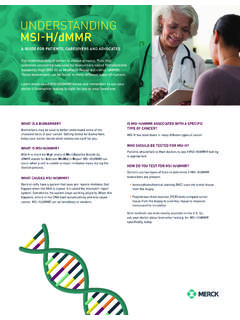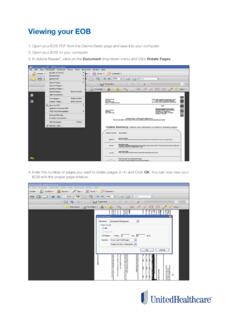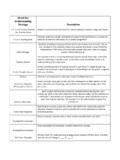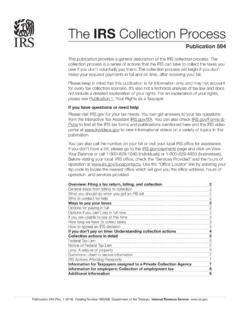Transcription of Understanding Your Waist-to-Hip Ratio - Healthyroads
1 American Specialty Health Incorporated (ASH). All rights reserved. 1 Understanding your Waist-to-Hip Ratio Maintaining a healthy weight can help you in many ways. Being overweight can raise your risk of health issues such as heart disease, Type 2 diabetes, arthritis, and some types of cancers. The good news is that you can take steps toward lowering your health risks. First, you will want to know what a healthy weight for you looks like. One way to do this is to find your Waist-to-Hip Ratio . You can use this worksheet to learn more about your Waist-to-Hip Ratio and to keep track of your numbers. Step 1: Measure your waist and Hips To measure your waist : Place the tape around the narrowest point of your waist . This is most oftenjust below your rib cage and just above the top of your hip bones. If there is noclear narrowing of your waist , measure at the level of your navel. Breathe out. Take the measure your hips: Stand with your feet together. Measure your hips at their widest point.
2 This is often around the widest part ofthe a friend or relative to help you measure your waist and hips. Be sure to use a tape measure that doesn t stretch. Keep it level and even with the floor as you measure. Lay the tape measure against your skin. Don t pull it tight or let it press your skin down. Always measure at the same place each time you measure your waist and hips. Step 2: Record your waist and Hip measurements and Calculate your Ratio Enter your waist and hip measurements in inches. Then, divide your waist measurement by your hip measurement. This is your Waist-to-Hip Ratio . American Specialty Health Incorporated (ASH). All rights reserved. 2 You can use this chart to record your measurements. Date waist Measurement (in inches) Hip Measurement (in inches) Waist-to-Hip Ratio Step 3: Know your Goal Numbers waist Goal Numbers For adults of non-Asian descent, your goal numbers are: Women: Goal is 35 inches or less Men: Goal is 40 inches or lessFor adults of Asian descent, your goal numbers are: Women: Goal is 31 inches or less Men: Goal is 35 inches or lessWaist-to-Hip Ratio Goal Numbers For all adults, your goal numbers are: Women: Goal is below Men: Goal is below 4: Understand What your Numbers Mean American Specialty Health Incorporated (ASH).
3 All rights reserved. 3 your waist size indicates how much fat is in the middle of your body. When fat collects in the belly area, the person has an apple shape. If fat tends to collect in the hips or thighs, the person has a pear shape. It s the fat in the belly area that is a health concern. Too much belly fat can lead to health problems. A larger waist is linked with a risk of high blood pressure and low levels of good cholesterol. These are risk factors for heart disease, diabetes, and other health conditions. your hip measurement by itself is not an indication of disease risk. It is most helpful when looked at as a Ratio with your waist measurement. your Waist-to-Hip Ratio can suggest your risk for heart disease. You can think of this Ratio as reflecting your body shape. If you are shaped like an apple, with a larger waist and smaller hips, you will have a higher Waist-to-Hip Ratio . This may mean that you have a higher risk for heart disease. If you are shaped like a pear, with a smaller waist and larger hips, you will have a lower Waist-to-Hip Ratio result.
4 You are likely to have less risk for heart disease. A Waist-to-Hip Ratio greater than for women or for men indicates abdominal obesity and an elevated risk of disease. Talk with your doctor if your Waist-to-Hip Ratio results suggest that you may have an increased risk for disease. Where are you now with your waist measurement and Waist-to-Hip Ratio ? Is one of these out of normal range? More than one? _____ Step 5: Take Steps to Reach or Maintain a Healthy Weight and waist Measurement Whether you are in normal range and trying to stay there or you have weight or inches to lose, the recommendation is the same: Move more and eat more fresh foods that are low in added sugars, salt, and saturated and trans fats. Keep stress under control. Here are some ideas to help you get started. American Specialty Health Incorporated (ASH). All rights reserved. 4 Move more Aerobic activity works your heart and lungs, and burns calories. The key is to choose activities you enjoy.
5 You want to look forward to exercising. Tips to help make exercise fun: Find a workout buddy. Choose fun activities. Change your routine. Do not get discouraged. Do not give up. Set and track your is one way you can add more activity to your daily routine? _____ Eat healthy foods Here are ways you can change your eating plan to be more healthy: Eat a piece of fruit each day. Add a new vegetable to your lunch or dinner. Choose a new low-fat dairy item to get more calcium. Cut out an item you eat that has trans fat listed on the ingredients label. Cut out a fried food you eat often. Switch to whole grain bread and cereal. Look for a new way to prepare a veggie is one change you can make this week to your diet to eat more healthy? _____ American Specialty Health Incorporated (ASH). All rights reserved. 5 This information is not intended to take the place of regular medical care or advice. Please check with your doctor before using this information or beginning any self-care program.
6 Credits Primary Author: Sharon Odegaard Last Clinical Reviewer: Leilani Fraley, RN Last Review and Approval: Leilani Fraley, RN, 11/09/2017 References American Council on Exercise. (2013). Know your numbers: Body mass index. Retrieved from Centers for Disease Control and Prevention. (2017). Healthy weight. Retrieved from Clark, J. E. (2015). Diet, exercise or diet with exercise: Comparing the effectiveness of treatment options for weight-loss and changes in fitness for adults (18-65 years old) who are overfat, or obese; systematic review and meta-analysis. Journal of Diabetes and Metabolic Disorders, 14, 31. doi: Harvard School of Public Health. ( ). waist size matters. Retrieved from Nuttall, F. Q. (2015). Body mass index: Obesity, BMI, and health: A critical review. Nutrition Today, 50(3), 117-128. doi: Reis, J. P., Allen, N., Gunderson, E. P., Lee, J. M., Lewis, C. E., Loria, C. M., .. Liu, K. (2015). Excess body mass index- and waist circumference-years and incident cardiovascular disease: The CARDIA study.
7 Obesity (Silver Spring), 23(4), 879-885. doi.









